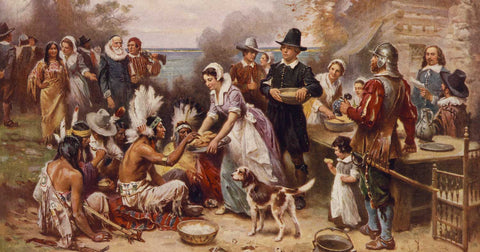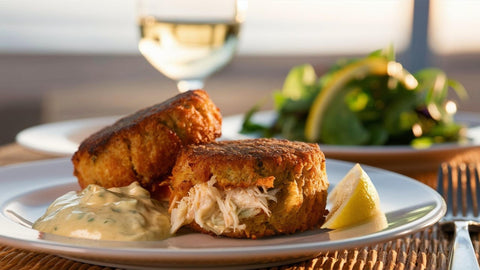When we think of Thanksgiving today, images of roasted turkey, cranberry sauce, mashed potatoes, and pumpkin pie likely come to mind. However, the menu at the very first Thanksgiving in 1621, shared between the Pilgrims and the Wampanoag people, was quite different. The feast was a celebration of the harvest and the alliance between the two groups, and it featured a diverse spread of seasonal foods that reflected what was available in New Englan
When most people think of Thanksgiving, they picture a feast of roasted turkey, mashed potatoes, cranberry sauce, and pumpkin pie. However, the very first Thanksgiving in 1621 looked quite different. This historic gathering between the Pilgrims and the Wampanoag people was a celebration of a successful harvest and a symbol of their alliance. The menu reflected the seasonal foods available in New England at the time, showcasing a diverse and resourceful spread.
The Historical Background
The first Thanksgiving took place in the fall of 1621 at Plymouth Colony. About 50 Pilgrims and 90 Wampanoag people joined together for a multi-day feast. Though the exact date remains unknown, historians believe the celebration occurred between late September and early November.
The Wampanoag, led by Chief Massasoit, were instrumental in helping the Pilgrims survive their first difficult year. They taught them how to plant corn, fish in local waters, and hunt in the region. Their knowledge and generosity were key to the success of the harvest and played a crucial role in the celebratory feast.
What Was on the First Thanksgiving Menu?
While no exact menu records exist, historical accounts and knowledge of local ingredients provide insight into what was likely served:
1. Venison (Deer)
Edward Winslow, a Pilgrim present at the feast, recorded that the Wampanoag brought five deer. Venison was a prized protein and likely a main dish at the meal, prepared through roasting or stewing.
2. Wildfowl (More Than Just Turkey)
Although wild turkeys were present in the region, the Pilgrims’ records mention “wildfowl,” which could have included ducks, geese, and even swans. Turkey may have been on the table, but it was not the centerpiece of the meal as it is today.
3. Seafood
Given the proximity to the Atlantic, seafood was abundant. The feast likely featured fish such as bass and cod, as well as shellfish like clams, mussels, and fresh lobster. Seafood was a staple in both the Pilgrims' and Wampanoag diets.
4. Corn
Corn, or "maize," was a key crop for the Wampanoag and a new staple for the Pilgrims. Instead of being eaten on the cob, it was dried and ground into cornmeal for porridges, breads, or stuffing.
5. Beans and Squash
As part of the “Three Sisters” agricultural method, beans and squash were commonly grown alongside corn. Squash was likely roasted or boiled, and beans may have been used in stews.
6. Nuts and Fruits
New England in the fall provided a variety of nuts such as walnuts, chestnuts, and beechnuts. Wild fruits like plums, grapes, and berries were available, but not in the sweet desserts we enjoy today.
7. Root Vegetables and Herbs
The Pilgrims' gardens contained root vegetables like onions and carrots, which may have been harvested for the feast. European herbs like thyme and sage were also likely used to season dishes.
What Was Missing from the Table?
Many modern Thanksgiving staples were absent from the first feast:
- Potatoes: Both white and sweet potatoes had not yet arrived in North America.
- Cranberry Sauce: While cranberries were native, sugar was scarce, making cranberry sauce unlikely.
- Pumpkin Pie: Pumpkins were available, but without butter and wheat flour, pies were not possible. Instead, pumpkins were likely roasted or stewed.
The Meaning of the First Thanksgiving
The first Thanksgiving was more about gratitude and survival than it was about replicating a modern holiday tradition. The Pilgrims were thankful not just for their harvest, but also for the Wampanoag’s guidance in adapting to their new land.
Although today’s Thanksgiving feasts look quite different, the spirit of togetherness and thankfulness remains unchanged. The original menu reflected the region’s natural bounty and the collaborative efforts between two cultures.
Conclusion: A Feast Steeped in History
The first Thanksgiving was a true reflection of early American history, featuring the foods that were available in New England at the time. While our modern holiday meals have evolved, understanding the original feast provides a deeper appreciation for the traditions that continue to bring people together.
By exploring what was actually served at the first Thanksgiving, we gain insight into the resourcefulness and resilience of the Pilgrims and the generosity of the Wampanoag. Whether you're a history enthusiast or simply curious about the origins of the holiday, knowing the truth behind the first Thanksgiving offers a fascinating look into the past.
d at the time.The Historical Context
The first Thanksgiving feast was held in the fall of 1621, after the Pilgrims’ first successful harvest in Plymouth Colony. Approximately 50 Pilgrims and 90 Wampanoag joined together for the multi-day celebration. While the exact date is not known, it likely occurred sometime between late September and early November.
The Wampanoag, led by Chief Massasoit, played a significant role in helping the Pilgrims survive their first year, teaching them how to cultivate corn, fish the local waters, and hunt in the unfamiliar territory. Their contributions to the feast were just as important as the Pilgrims', with the menu reflecting a combination of both groups' food traditions.
What Was Actually on the Menu?
While there's no written record of the exact menu, historians have pieced together what was likely served based on historical accounts, local ingredients, and the culinary practices of both the Pilgrims and the Wampanoag. Here’s what we know:
1. Venison (Deer)
According to accounts from Edward Winslow, one of the Pilgrims present at the feast, the Wampanoag guests brought five deer to share. Venison was likely a centerpiece of the meal and would have been roasted or stewed.
2. Wildfowl (Not Just Turkey)
The Pilgrims did hunt wildfowl, but the term covered more than just turkey. It likely included ducks, geese, and even swans, which were plentiful in the region. While turkey might have been on the table, it was not the star dish as it is today.
3. Seafood
Living near the coast, the Pilgrims and Wampanoag had access to a variety of seafood. Fish like bass and cod were likely served, as well as shellfish such as clams, mussels, and even fresh lobster. In fact, seafood was a staple in their diet due to its abundance in New England waters.
4. Corn
Corn, or "maize," was a central crop for the Wampanoag and a new staple for the Pilgrims. However, it wasn’t the sweet corn we think of today. Instead, corn would have been dried and used to make cornmeal, which could be turned into bread, porridge, or stuffing for other dishes.
5. Beans and Squash
As part of the “Three Sisters” of Native American agriculture (corn, beans, and squash), these vegetables were likely served. Squash could have been roasted or boiled, and beans were probably mixed into stews.
6. Nuts and Fruits
New England in the fall is rich with nuts like walnuts, chestnuts, and beechnuts, which were likely gathered and eaten during the feast. Wild fruits such as plums, grapes, and berries were also available and may have been incorporated into the meal, though not in the form of the sweet desserts we enjoy today.
7. Roots and Herbs
The Pilgrims had gardens that included onions, carrots, and other root vegetables, which may have been harvested for the feast. Herbs like parsley, thyme, and sage, introduced from Europe, were likely used to season the dishes.
What Wasn't on the Table?
It’s equally important to note the foods that were absent from the first Thanksgiving. Many dishes that are now staples of the modern holiday were not part of the 1621 celebration:
- Potatoes: Potatoes, both sweet and white, hadn’t made their way to North America yet, so there were no mashed potatoes or sweet potato casseroles.
- Cranberry Sauce: While cranberries were abundant in New England, there’s no evidence that they were served as a sauce. The sugar necessary to make cranberry sauce was a rare commodity at the time.
- Pumpkin Pie: Pumpkins and other squashes were likely present, but there were no pies. The Pilgrims lacked butter and wheat flour, so they couldn't make the crusts. Instead, they may have roasted or stewed the pumpkins.
The Spirit of the First Thanksgiving
The first Thanksgiving was more about survival, gratitude, and the forging of an important alliance than it was about replicating the traditions we now associate with the holiday. The Pilgrims were grateful not only for their successful harvest but also for the support and friendship of the Wampanoag people, who had helped them endure a harsh winter and learn to thrive in their new home.
While the menu was likely unfamiliar to modern palates, the spirit of togetherness and gratitude that defined the first Thanksgiving is what continues to resonate today. The foods may have changed, but the meaning of the celebration endures.
Conclusion: A Feast Rooted in History
The first Thanksgiving was a far cry from the holiday we celebrate today, with a menu that reflected the bounty of the New England landscape and the diverse food traditions of the Wampanoag and Pilgrim communities. While turkey and pie may dominate our tables now, the original feast was a rich celebration of survival, community, and gratitude—values that continue to be at the heart of the holiday.
This historically accurate look at the first Thanksgiving offers a fascinating glimpse into the origins of one of America’s most beloved holidays and serves as a reminder of the deep connections between food, history, and culture.
By remembering what was really served at the first Thanksgiving, we not only honor the past but also gain a greater appreciation for the diverse influences that shaped the meal. Whether you're a history buff or just curious about the true story, understanding the first Thanksgiving's menu is a journey back in time to the roots of this cherished tradition.





